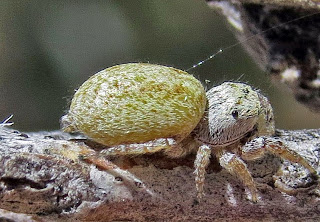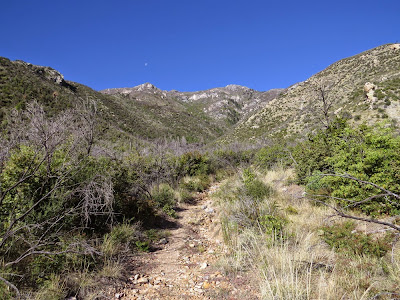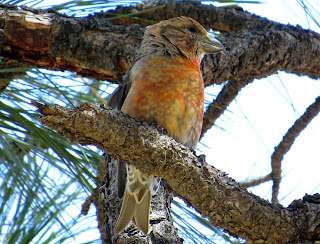This time, the successfully introduced Chukar. This was on my Oregon in Spring tour yesterday, on the way to Fields, Oregon. Today we drive back to Portland, our last day of the tour.
Tuesday, May 26, 2015
Sunday, May 24, 2015
If a California Quail Has a Comma On Its Head...
If a California Quail has a comma on its head...
...then a Mountain Quail has an exclamation point. This was on Aldrich Mountain this afternoon.
...then a Mountain Quail has an exclamation point. This was on Aldrich Mountain this afternoon.
Saturday, May 23, 2015
Malheur Is...
Malheur is...
Abundant water birds with great views. Wilson's Snipe.
Migrants at Headquarters. Evening Grosbeaks at the feeders.
Vagrants. Least Flycatcher at P Ranch.
Abundant water birds with great views. Wilson's Snipe.
Migrants at Headquarters. Evening Grosbeaks at the feeders.
Vagrants. Least Flycatcher at P Ranch.
Friday, May 22, 2015
Brief Report From Oregon
My Oregon in Spring tour is going well, but days are long, and no time to blog if I want any sleep. We're half over already, and today had many highlights. One was my favorite bird, this Calliope Hummingbird, at Calliope Crossing north of Sisters.
Wednesday, May 13, 2015
In Search of Soapberry Hairstreaks
This past
Sunday, May 10, against my better judgment in view of the fact that I was home
for only two days after guiding at Southwest Wings and still had to pack and
prepare for a seven-week trip to three states and four guiding jobs, I went out
birding and butterflying with my friends Mary, Fred, and Gary. Mary was
practically promising me Soapberry Hairstreaks in Molino Canyon just northeast of Tucson, a species of
butterfly I have wanted to see for many years. The adults fly around their host
plant (Western Soapberry, Sapindus
saponaria, here var. drummondi)
only during May, after they emerge from their chrysalides. The adults lay eggs,
which remain dormant on the twigs until new leaves emerge the following spring.
The adults die soon after they lay their eggs, so this is the only time you can see them in this
stage of their life cycle. It’s an odd hairstreak, being the only member of its
genus.
We first
stopped at this steep draw on the lower Catalina Highway. Only during the mid-morning
hours does it get sun, and the rarish Cestus Skipper is known from here, due to
the presence of its host plant, Bamboo Muhly. And we saw one; this being only
my third Cestus Skipper very soon after my second just a week and a half ago.
While
clambering on the rocks to get close to the host plant, I noticed a lovely
little composite growing straight out of the rock wall. It is Lemmon's
Rockdaisy, Perityle lemmonii. I
particularly like composites like this with no ray flowers. It has extremely
brittle stems, but where it grows it probably gets few direct wind gusts and
no perching birds or animals.
We then
moved up the road less than a mile to the Molino Vista overlook, where a nice
patch of Western Soapberry grows near the stream bed. We spent nearly 4 hours
here and never did see Soapberry Hairstreak, but we did see other hairstreaks
and a bunch of other things.
I had
actually forgotten what to look for in Soapberry Hairstreak, so when I saw an
unusual hairstreak that clearly wasn’t the abundant Gray Hairstreak, I got
excited and thought I had one. Then Gary came over and corrected my
identification: this was a rare Mallow Scrub-Hairstreak, Strymon istapa, only the second one I’ve ever seen in Arizona, and
a much rarer bug than Soapberry Hairstreak. “Better than a Soapberry!” said
Fred, but since I had seen one of these before, even in my yard, I had a
different view of which was “better.”
We walked
nearly ½ mile up the canyon bottom, past the Western Soapberries and looked at
all bugs on the moist sand and sipping nectar from the abundant Catclaw Mimosa,
Mimosa aculeaticarpa. I also looked
at the birds. This just-fledged Bell’s Vireo was a constant noise at one spot.
Near the
parking lot was this spotted whiptail that defies identification. The
relatively well-pronounced stripes that are not particularly bright on the rump
or neck; the well-pronounced spots that are visible between and within the
stripes but aren’t particularly bright and yellow on the hind legs; the bluish
cast to the throat; the olive tail; and the fact that we are in the Santa
Catalina Mountains of NE Pima County, all do not match up to anything at
reptilesofaz.org. But it does at least seem to be one of the parthenogenetic,
female-only species of hybrid origin.
This
milkweed bug appears to be Lygaeus
reclivatus.
I spotted
this tiny, cream-colored jumping spider on the soapberry twigs while I was
searching for caterpillars. I wondered if it specialized on hunting from this
particular plant.
This bee
fly, Poecilanthrax poecilogaster, was
one of the more common insects in the canyon this morning.
Although I
saw and heard only 33 species of birds, our group list of butterflies totaled
over 40. This Erichson's White-Skipper, Heliopyrgus
domicella, is regular but never common in these foothill canyons.
This metalmark,
Apodemia sp, is a bit of a taxonomic
problem here. It actually looks more like the Mormon Metalmarks of north of
here, with a lack of orange in the hind wing, but based on location should be
same as the Mexican Metalmark just a few canyons west of here, like the one I saw in Pima Canyon. We saw several, and they all looked like this one.
A relatively
common, and sometimes abundant hairstreak is this Leda Ministreak, Ministrymon leda, but I saw only two.
The
commonest hairstreak is Gray Hairstreak, Strymon
melinus, probably due to the fact that its caterpillars are happy eating a
huge variety of plants. I saw a few this morning but failed to get a photo of
one that was in pristine condition, unlike this tattered one.
I was not in
the least bit disappointed that we missed Soapberry Hairstreak, as I had
already had a fabulous morning in good company, and I was not going to have any
chance to do any more outings in Arizona until September at the earliest. But
with just a hundred yards of canyon bottom left before we got back to the car,
Mary called out Silver-banded Hairstreak, and I came running. This is a
gorgeous bug, even when rather worn like this one, but I’ve wanted to see Chlorostrymon simaethis in Arizona for
many years; I’ve seen it in Baja California Sur, where its host plant is very
common.
This is a
very rare butterfly here, a wanderer far from any breeding population, and it
was even a new Arizona bug for Mary (who just three weeks ago discovered
Arizona’s first Clench’s Greenstreak). Fred had seen it but twice before in
Arizona. Its host plant is also a member of the soapberry family (Sapindaceae),
called Balloon Vine, Cardiospermum
corindum. Some sources give Faux Persil as an English name, which is rather
ridiculous since it’s French for “false parsley,” something that is more
sensibly used, by the French, for members of the carrot family that aren’t true
parsley, and further the only French-speaking places this species occurs
are some tiny Caribbean islands. Here’s the range map of plant specimens from
the Southwest Environmental Information Network, showing how far this butterfly
was away from where it may have emerged.
Here are
some happy butterfliers still enjoying the moment.
Tuesday, May 12, 2015
A Final Day of SW Wings Field Trips
My final
field trip for the Southwest Wings Spring Fling Birding Festival this past
Saturday was titled “Chasing Rarities.” The two obvious rarities in the nearby
Huachuca Mountains were Rufous-capped Warbler and Sinaloa Wren, so those were
our targets.
Rufous-capped
Warbler is one of the rarest breeding birds in the United States; there are only 2 or 3 known pairs in the
country. The pair we sought has been known in the rarely-visited Hunter Canyon
on the east side of the Huachuca Mountains since early September 2013. Who
knows how long they were there before being discovered. I had never been here
before, so it was fun getting know a new area.
While we
were looking, listening, and waiting at several different spots in the upper
canyon – the few times I played a bit of song there was no response – this
Greater Pewee came down just a few feet away to investigate my owl imitation.
We were
watching a male Ornate Tree-Lizard do pushups to impress a female when I caught
a bit of movement in the bushes nearby on the trail. Rufous-capped Warbler! It
foraged for a while, was joined briefly by a second bird, then it came over
towards us and sat up to sing. This was several minutes since I had played just
a couple songs, and this didn’t look like the typical excited response to
playback that I usually see in birds. I think we just lucked into being in the
right place at the right time.
On the way
down I photographed this Acmon (or Lupine or whatever) Blue. The taxonomy is
still in flux.
We then
spent a few hours in Huachuca Canyon on Fort Huachuca, hoping for the Sinaloa
Wren, but neither we nor another 20 birders, including a tour group, another
festival field trip, and lots of independent birders could find it. This is the
parking area by the stream where it is usually seen, but no one knows where it
goes when it disappears.
While
looking for the wren I looked up at a sycamore tree and noticed this
Black-necked Garter Snake about 7 feet off the ground. I had never seen one off
the ground before.
We finally
had to give up on the wren and worked on the participants’ wish lists. Up
canyon we found the recently arrived Sulphur-bellied Flycatchers and a female
Elegant Trogon, then in the grasslands towards Garden Canyon we scored Canyon
Towhee and Botteri’s Sparrow. On the way back to the Cochise College field trip
meeting site, we looked for Chihuahuan Raven, the species “known” to occur in
parking lots and visit dumpsters in Sierra Vista. Things have changed since I
birded Sierra Vista frequently 20 years ago. All we could find were Common
Ravens, including this one. Notice how the nasal bristles only cover the basal
half of the bill. This one also called, a typical throaty Common Raven croak.
Friday, May 8, 2015
A Second Day at Southwest Wings and More Owling
Just a few
photos from today’s long day of field trips for the SW Wings Birding Festival.
We started with good views of a Botteri’s Sparrow in the lower elevations then
saw the male Elegant Trogon in Ramsey Canyon, where it is a rare bird. We
walked up the canyon where we saw a lot of the regular madrean pine-oak
specialties such as Greater Pewee, Hepatic Tanager, Grace’s Warbler, and several
Painted Redstarts.
We then
worked up to Carr Canyon where we added all the sought-after warblers, such as
Virginia’s, Red-faced, and Olive (finally). A highlight was a flock of Red
Crossbills, which had at least two different types. This one appears to be Type
6, the largest and largest-billed of all the types, which are all probably good
species.
We ended the
day’s birding with 74 species. I then led a second owling field trip which was
a great success. Back up the Carr Canyon Road we re-found the same owls I had
found on Wednesday, including this Elf Owl sticking its head out of the nest
cavity.
This time I
got a photo of one of the very responsive Whiskered Screech-Owls. Notice the
little feet and green bill.
And this is
the same Western Screech-Owl as the other night. Notice the big feet and black
bill. Of course, they also sound very different.
We had these
three species of owls in just about 20 minutes, so we went a bit farther up the
road and tried for Common Poorwill. It seemed that we weren’t going to even
hear one for a while, but then one flew right overhead, popping its wings in
defense of its territory as I played its song. Then I spotted its eye shine in
my headlamp on a dirt bank above the road.
I played a
little bit of Mexican Whip-poor-will, and then to just demonstrate how
different it is from Eastern, I played that too, as well as the Mexican's closer
relative, the Dusky Nightjar from Costa Rica. Then a Mexican Whip-poor-will
began singing it’s “will-poor-whip” song just up the road, and within five
minutes it was flying over our heads. To wrap it up, we drove a few miles down
to Casa de San Pedro and finished out night with a ghostly Barn Owl also flying
overhead. Not a bad night.
Southwest Wings Birding Festival Spring Fling
I’m in the
middle of leading field trips for the “Spring Fling” of the Southwest Wings
Birding Festival in Sierra Vista, Arizona. This is their second year offering a
short festival of field trips only during the spring, while they still do a full-fledged festival
(with talks, workshops, vendors, displays, etc.) in August. I’ve been leading
field trips off and on for this festival since 1994.
Wednesday
night was my owling field trip, and we quickly connected with Elf Owl (in a
nest cavity in a dead Arizona Sycamore), a Whiskered Screech-Owl pair, and this
Western Screech-Owl.
The passage
of a front to the north of us brought some brutal winds up higher though, so
our attempts at seeing Flammulated or Spotted Owl and Mexican Whip-poor-will
were thwarted.
Then
yesterday (with the winds continuing), I took my group of nine participants to
a couple places on the San Pedro River, where we saw nearly 60 species of
birds, including a pair of Northern Beardless-Tyrannulets at their nest,
migrant Western Tanagers, and this handsome male Pyrrhuloxia.
Sunday, May 3, 2015
Violet-clouded Skipper in the Garden
I was
putting out fresh hummingbird food in the yard yesterday morning when I noticed this
small skipper on the purple asters.
I quickly
put the feeder up, put down my coffee, ran in for the camera and got the above
shot. Several minutes later I refound it in my garden, as it briefly landed on
the sneezeweed cultivars I planted in hopes of attracting butterflies, but then
it decided to sun itself on the tomato plants, where I took a bunch more
photos. It turns out to Violet-clouded Skipper, an uncommon bug in grassy
desert canyons, and downright rare in places like urban gardens. I’ve seen it
twice before, but never in the yard. The last time I saw one, coincidentally, was the last time I hiked into Pima Canyon with Jake Mohlmann, six years and
two months ago. I had seen it only one other time in Arizona, about three years
before that.
I realized I
hadn’t really figured out what these lovely purple asters are in the yard, so I
tried keying them out.
The species
that Kearney & Peebles (1951) led me to was Aster tephrodes. In the 1960 supplement they mention that it’s been
moved to the genus Machaeranthera.
Then sometime in the intervening decades it was changed to Machaeranthera asteroides, and then that genus has been changed
once again to the currently accepted Dieteria
asteroides, with the common name Fall Tansyaster.
It is very
close to Dieteria canescens, but if
the characters in K & P are still correct, this one shows the phyllaries
having the green tips relatively long, gradually narrowed, and bent back. D. canescens should have a very short
green tip that rather abruptly narrows from the white (“chartaceous”) basal
portion to the pointed tip. K & P also correctly characterize D. asteroides as occurring on alluvial soils (which our yard most
definitely is) and blooming as early as March, while D. canescens blooms after June.
While keying
it out, I noticed this miniscule and nearly transparent ambush bug, family Phymatinae.
Update 1: This is actually a lace bug, family Tingidae.
Update 1: This is actually a lace bug, family Tingidae.
There have
been plenty of Pallid-winged Grasshoppers in the yard all winter long, but this
was the first Gray Bird Grasshopper, Schistocerca
nitens, that I have seen this year.
Finally,
here are three shots of my little vegetable garden that I have been enjoying
for the past nearly three months. The first photo is from March 5, the second
is April 8, and the third is from April 29. I’ve already eaten three grape
tomatoes, one zucchini, several little crookneck squashes, a bouquet of
basil, and lots of kale.
Subscribe to:
Comments (Atom)








































.jpg)
.jpg)
.jpg)

.jpg)










